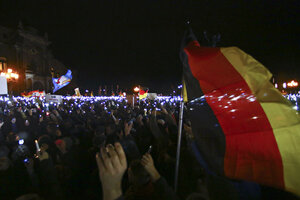Dresden's anti-Islam protests: Rooted in Germany's East-West divide?
PEGIDA marchers, some 17,500 of whom took to the street in Dresden tonight, claim that Islam threatens Germany. But their anger may stem in large part from issues held over from reunification.

Participants hold up lights during a demonstration called by anti-immigration group PEGIDA, a German abbreviation for "Patriotic Europeans against the Islamization of the West", in Dresden, Germany, tonight. About 17,500 opponents of Germany's policy towards asylum seekers and Islam attended the protest in the eastern German town, police said.
Hannibal Hanschke/Reuters
Berlin and Paris
The thousands of anti-Islamist protesters who’ve been gathering in Dresden each Monday – as they did tonight with a record 17,500 participants – to contest what they say is a radical brand of Islam, aren’t just shining a spotlight on a rare glimpse of public xenophobia in Germany.
The group, called “Patriotic Europeans Against Islamization of the West,” or PEGIDA, is evidence of a stubborn dividing line across Germany, even as the 25th anniversary of the fall of the Berlin Wall was celebrated in a mega bash in Berlin this November.
The PEGIDA protests, which have been building for weeks in Dresden, are not an absolute anomaly. A similar march shocked the prosperous city of Cologne, in western Germany, at the end of October, and flashes of intolerance have played out in Germany’s capital Berlin and beyond. Dresden has long been home to an annual neo-Nazi march.
But the staying power of PEGIDA in Dresden underlines a gap between East and West Germany, in which the former faces higher unemployment, exclusion, and crucially, far lower rates of immigration – and consequently less tolerance. Some observers fear the marches here could ultimately stoke flames that populists could capitalize on. It’s a delicate balance for mainstream political parties in a country that’s been, until now, a magnet for foreigners – and for one that desperately needs them.
“East Germany hasn’t experienced migration as much as the rest,” says Hajo Funke, a political science professor at the Free University Berlin. “They have not interacted with [migrants] so much, so that’s one reason why they can better project their fears and frustrations onto migrants.”
Two responses to immigrants
The mainstream German view is a welcoming one, especially compared to the rest of Europe. According to this year’s Transatlantic Trends survey at the German Marshall Fund of the US, two-thirds of Germans say they are not worried about immigration from within the EU. And Germany showed the highest percentage of respondents willing to have less restrictive refugee policies, at 31 percent.
German Chancellor Angela Merkel spoke out against the marches in Dresden last Monday, saying there is "no place for spreading hatred and slander against people who come to us from other countries." And in Munich tonight, 10,000 people marched in a counter-protest against PEGIDA.
Still, the PEGIDA marches shows a segment of the population that does not share the dominant mood.
Like the rest of Europe, Germany has grappled with its nationals returning from the battlefields of Syria and Iraq and posing a domestic security threat. Muslim radicals in Germany also made news in September when a patrol of “Shariah Police,” as they labeled themselves, roamed the streets of the city of Wuppertal to “police” alcohol consumption.
Gary Hochenstein, a 63-year-old who lives an hour outside of Dresden, says his support for Pegida isn’t “official” but that he agrees with most of what they are saying. “I feel that their mission is to educate people about the dangers of radical Islam and not let the Muslims impose their ‘beliefs’ on non-Muslims,” he says.
Fear of the unknown
But more than just reflecting fear of Islam, the marches are also about fear of the unknown, say some German observers.
With each Monday march in Dresden, a counter demonstration has emerged, some organized by Veit Kuehne, who founded International Friends-Dresden in October 2013. He says that Easterners need more experience with migration to get beyond misunderstandings. Many migrants in Dresden, for example, come to study and work, and are helping the economy, not hurting the local population.
Mr. Kuehne facilitates meet-ups and cultural exchanges aimed at broadcasting that message – something needed with a lack of the day-to-day interaction that is more common in Berlin or prosperous West German towns. “In the West, people have lived for so long with foreigners that they have learned they’re not bad,” he says.
Omar Valdés García, a politics student and nurse in Dresden from Spain, says that the only other time in recent history that immigration rates in Germany have been so high was in the 1990s, amid an influx of immigrants from the former Soviet bloc. That coincided with a period of transition and crisis for the people of East Germany, marked by the end of state support and massive unemployment.
“The workers, especially the more aggrieved class, began to blame for this situation the only ones who were under them, the immigrants,” Mr. Valdés García says, adding that since the 2008 crisis, old resentments have resurfaced.
Dr. Funke agrees. “They feel powerless, cut off by the societal political development and especially due to the experiences of the '90s.”
Moreover, he adds, political leaders will have to walk a fine line in response. Politicians will have to “be efficient and responsive to the needs of the people and the respective neighborhoods on one hand, and how to be responsive and fair to the refugees who come.”

